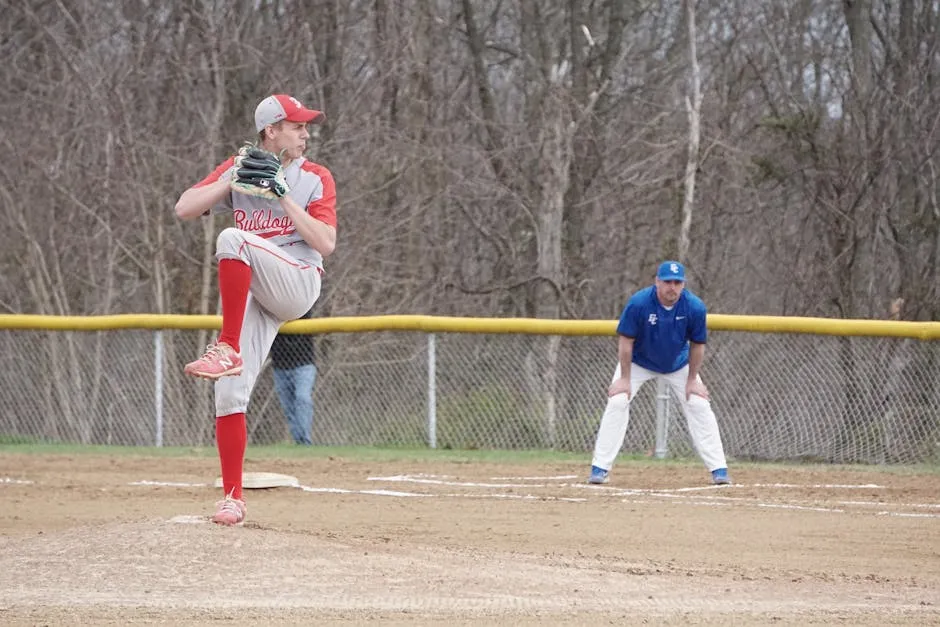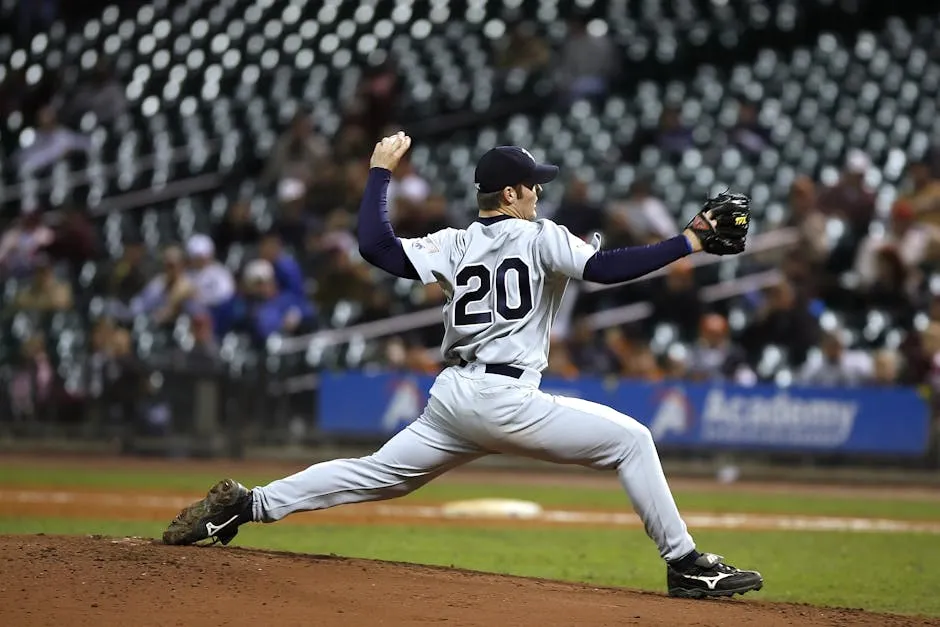
Why Do Pitchers Only Throw 5 Innings?
Modern baseball has revolutionized pitching strategies. In the past, starting pitchers regularly went deep into games. Today, it’s common for pitchers to last only five innings. But why has this change occurred?
Introduction
The evolution of pitching in Major League Baseball (MLB) reflects significant shifts in strategy and player management. Historically, pitchers were expected to throw complete games, sometimes exceeding 200 innings in a season.
Now, the focus on pitch counts has transformed how teams utilize their pitchers. A typical pitch count cap is around 100 pitches, which directly impacts how long a pitcher remains in the game. This shift prioritizes player health and performance statistics while reshaping game strategy.
If you’re looking to dive deeper into the technical aspects of pitching, consider checking out the Baseball Pitching Mechanics Book. This book will help you understand the nuances of pitching mechanics and can be a game-changer for aspiring pitchers.
As we unpack this trend, we’ll look at factors like pitch counts, the advancement of hitters, and injury prevention, illustrating how these elements contribute to the five-inning standard.

The Evolution of Pitching in MLB
Traditionally, starting pitchers in baseball were expected to pitch deep into games, often completing them. Legendary pitchers like Tom Seaver and Nolan Ryan regularly threw over 250 innings each season. In the 1970s, it was common for pitchers to average around 15 complete games per year.
Statistics reveal that many prominent pitchers consistently exceeded 300 innings in their prime. For instance, Bert Blyleven averaged 273 innings annually from 1971 to 1979. Such expectations shaped the entire pitching landscape.
However, as the game evolved, the approach to pitching began changing. Starting pitchers now often have shorter outings, reflecting a broader shift in how the game is played. The emphasis on specialized roles within pitching staffs has emerged, highlighting the need for pitchers to adapt to new strategies.
Don’t forget to equip yourself with the right gear! A quality MLB Official Baseball is essential for practice and games. It’s the perfect way to ensure you’re playing with the best quality equipment.
In the next section, we’ll explore how managerial strategies have shifted in response to these changes.

Changes in Game Strategy
Baseball has changed dramatically over recent years, particularly in how managers handle pitchers. The focus has shifted from expecting starters to go deep into games to leveraging specialized roles. Managers now prioritize matchups and strategize based on a pitcher’s strengths against specific hitters.
This approach has led to the rise of specialized roles within pitching staffs. There are now distinct categories for pitchers, such as middle relievers and closers. Middle relievers come in during pivotal moments, often to face a couple of batters. Closers, on the other hand, are brought in to secure the final outs of a game.
These strategic changes impact the entire game. With starters often pitching just five innings, bullpens have become critical. Managers rely on fresh arms to maintain performance late in games. This evolution keeps games dynamic and competitive, changing how teams construct their rosters and approach each game.
To keep track of all those pitches, a reliable Pitch Count Tracker is invaluable for any coach or player. It helps manage pitch limits effectively, ensuring that pitchers stay healthy and perform their best.

Factors Influencing the Five-Inning Standard
Pitch Counts
Pitch Counts
Pitch counts refer to the total number of pitches a pitcher throws during a game. They play a vital role in modern baseball, especially concerning pitcher health and performance. Teams typically set a limit of around 100 pitches for starting pitchers. Exceeding this threshold can increase the risk of injury and fatigue.
Statistics show a clear correlation between pitch counts and innings pitched. For instance, a pitcher with a high pitch count often struggles to maintain effectiveness. Many starters today average around 85-90 pitches per game, which commonly leads to them exiting after five or six innings. This limit helps teams prioritize long-term pitcher health while ensuring peak performance during games.

Increased Hitter Proficiency
Increased Hitter Proficiency
Modern hitters have seen significant advancements in training and technology. These improvements have led to a more selective and patient approach at the plate. Hitters now analyze pitchers’ tendencies using video and data analysis, making them tougher opponents.
For example, hitters are less likely to chase pitches outside the strike zone, leading to longer at-bats. As a result, pitchers may face increased pitch counts, forcing them out of games earlier. This evolution in hitting has made it challenging for starting pitchers to consistently go deeper into games. As the game continues to evolve, the dynamic between pitchers and hitters will remain a crucial aspect to watch.

Injury Prevention and Player Health
Injury Prevention and Player Health
Managing pitchers’ workloads is essential for reducing injury risks. Pitching places significant strain on the arm and shoulder. Overworking pitchers can lead to serious injuries, impacting their careers.
Teams now closely monitor young pitchers, especially during development. They often impose strict pitch counts to safeguard their health. For instance, a common limit is around 100 pitches per game. Exceeding this number can increase the risk of fatigue and injury.
Statistics reveal a worrying trend. Studies show that injuries among pitchers have risen sharply in recent years. Reports indicate that Tommy John Surgery Recovery Book, a common procedure for pitchers, has become more prevalent. Recovery from this surgery can take anywhere from 12 to 18 months, sidelining pitchers for an extended period.

Teams are also focusing on educating young athletes. They emphasize proper mechanics and conditioning to enhance durability. By prioritizing health, teams hope to extend their pitchers’ careers and effectiveness.
The Role of the Bullpen
The Modern Bullpen Structure
The Modern Bullpen Structure
The bullpen has evolved into a critical component of modern baseball strategy. Historically, teams relied on a few pitchers to complete games. Now, specialized roles dominate the landscape. Bullpen arms are specifically designated for different game situations.
Setup men prepare the way for closers, often pitching in the eighth inning. They face tough hitters to maintain a lead. Closers then come in to secure the win, often in high-pressure scenarios. This specialization allows teams to maximize each pitcher’s strengths.
Statistics highlight the bullpen’s growing impact on game outcomes. In recent seasons, teams with stronger bullpens have consistently performed better. A well-rested and efficient bullpen can turn the tide in tight games.

Moreover, the average inning pitched by relievers has decreased, emphasizing efficiency. Relievers often throw fewer pitches than starters, which keeps them fresh for critical moments. This dynamic has reshaped how managers approach game strategy, making the bullpen a focal point.
As baseball continues to evolve, the bullpen’s role will only become more significant. Teams that effectively manage their relievers will find greater success in this highly competitive environment. Also, if you’re looking to improve your pitching skills, consider investing in Pitching Training Aids. These tools can enhance your practice sessions and help you refine your mechanics.

Managerial Decisions
In baseball, the decision to pull a starting pitcher is often strategic. Managers weigh various factors when determining the right moment for a change. Primarily, performance and fatigue play crucial roles in this decision-making process.
When a pitcher starts to struggle, managers must assess whether the decline is temporary or indicative of ongoing issues. A sudden spike in pitch count can signal fatigue. If a pitcher throws a high number of pitches early in the game, it may lead to decreased effectiveness later on.
For instance, during a recent game between the Atlanta Braves and New York Mets, Braves’ manager Brian Snitker chose to pull his starter after five innings. Despite allowing only two runs, the pitcher had already thrown 100 pitches. Snitker explained that the team’s plan was to protect their pitcher’s arm for the long season ahead.

Moreover, managers often rely on their bullpen’s strengths. If a matchup favors a specific reliever against the upcoming hitters, a pitching change becomes more likely. This strategic approach maximizes the chances of winning. Speaking of winning, a Baseball Scorebook can be an excellent tool for coaches to keep track of all game events and strategies!
As teams continue to prioritize player health and performance, these managerial decisions will shape the future of pitching in baseball.

Impact on Pitching Statistics and Wins
Changing Win Criteria for Pitchers
Changing Win Criteria for Pitchers
The criteria for earning a win has changed significantly over the years. Traditionally, a starting pitcher had to complete at least five innings to qualify for a win. However, this expectation has evolved with the rise of specialized pitching strategies.
Now, many pitchers leave games after five innings, often due to pitch count limits or performance factors. This trend has implications for win-loss records. It can skew how fans view a pitcher’s effectiveness.
Statistics reveal that a growing percentage of wins are credited to pitchers who throw fewer than five innings. In recent seasons, around 30% of wins have gone to starters who pitched less than five innings. This change reflects a broader strategy focused on managing pitchers’ workloads.

The evolving criteria for wins challenges traditional perceptions. It emphasizes the importance of the entire pitching staff, rather than solely the starting pitcher. As the game continues to transform, understanding these statistics becomes crucial for fans and analysts alike.
In summary, the modern approach to pitching, characterized by shorter outings and specialized roles, has reshaped the landscape of baseball statistics. It’s essential to recognize how these changes affect our interpretation of pitching performance and team success. And hey, if you want to keep your stats on point, a Baseball Stats Tracker could be just what you need!

Historical Comparisons
Historical Comparisons
In modern baseball, pitching statistics tell a different story than those from the past. Historically, pitchers were expected to complete games. For example, Tom Seaver, a legendary Mets pitcher, regularly threw over 250 innings in a season. In contrast, today’s starters often aim for five innings.
The definition of a “quality start” has also evolved. Traditionally, a quality start meant pitching at least six innings while allowing three earned runs or fewer. Nowadays, many fans and analysts consider a quality start to be simply five innings pitched with three earned runs or less. This shift reflects a broader change in how the game is managed.

Data shows that fewer pitchers achieve quality starts today compared to past eras. For instance, in the 1970s, about 65% of games featured pitchers completing six or more innings. In contrast, recent seasons show only around 45% of starters reach that threshold. This dramatic decline highlights the modern emphasis on pitch counts and specialized bullpen usage. As the game continues to change, understanding these historical comparisons helps us appreciate the current pitching landscape.
Conclusion
In summary, pitchers today often only throw five innings due to changing strategies, health considerations, and the evolution of the game. The focus on pitch counts has reshaped how teams manage their pitchers, with the bullpen playing a vital role in game outcomes. As these trends continue, it will be interesting to see how they impact the future of pitching in baseball. Consider how this shift alters your view of the game and the strategies involved. Are you ready to embrace this new era of baseball? And while you’re at it, why not grab a fun Baseball Trivia Game to challenge your friends on all things baseball!
Please let us know what you think about our content by leaving a comment down below!
Thank you for reading till here 🙂
All images from Pexels




